Organisation Behaviour Report: Culture, Motivation, Power
VerifiedAdded on 2020/07/23
|16
|5204
|219
Report
AI Summary
This report delves into the multifaceted field of organizational behaviour, examining how culture, politics, and power influence individual actions within a venture. It explores the impact of organizational culture, emphasizing how shared values and beliefs shape employee conduct, and discusses the influence of power dynamics, including different types of power and their effects on employee behaviour. The report further analyses the role of politics in the workplace and suggests strategies to mitigate its negative impacts. Additionally, it covers Hofstede’s dimensions of culture, explaining how these dimensions affect organizational practices and employee interactions, and the impact of globalization and digital technology on organizational culture. The report also evaluates various motivational theories, such as Maslow's hierarchy of needs and Adams’ equity theory, to understand how to effectively motivate individuals and teams to achieve goals. It highlights the importance of both internal and external motivation, providing insights into how organizations can create environments that foster employee engagement and productivity. Finally, the report touches upon effective cooperation and leadership approaches, underscoring the importance of these elements in achieving organizational success.
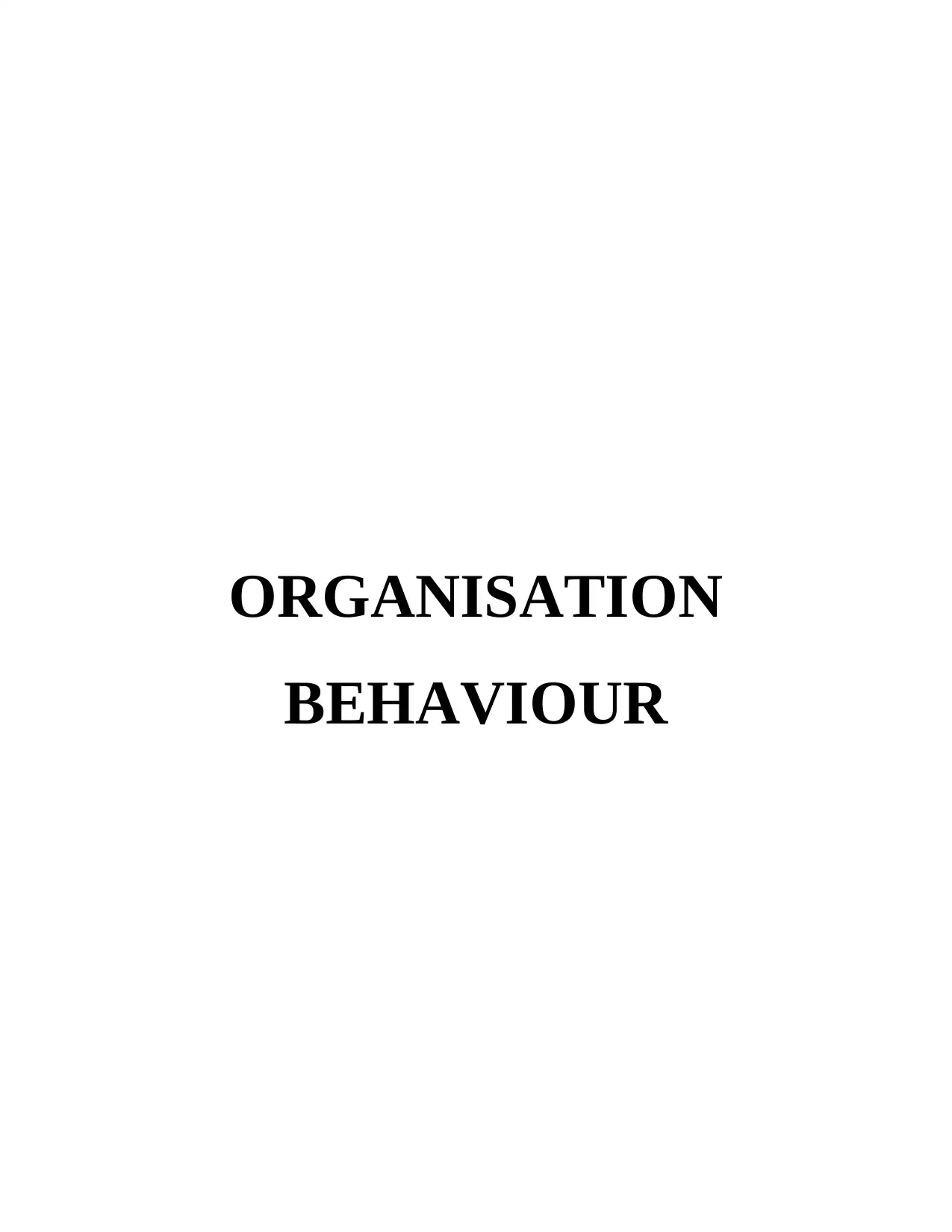
ORGANISATION
BEHAVIOUR
BEHAVIOUR
Paraphrase This Document
Need a fresh take? Get an instant paraphrase of this document with our AI Paraphraser
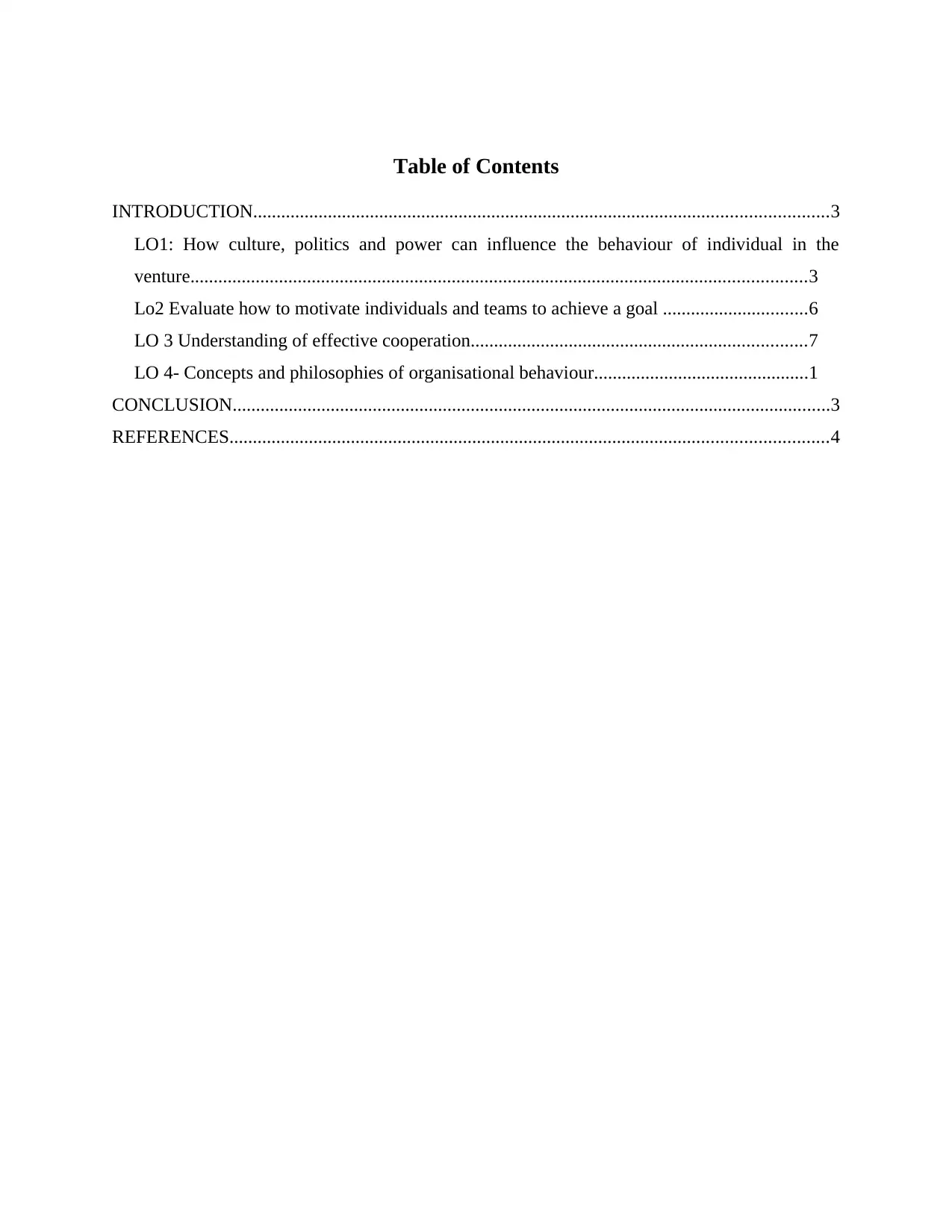
Table of Contents
INTRODUCTION...........................................................................................................................3
LO1: How culture, politics and power can influence the behaviour of individual in the
venture....................................................................................................................................3
Lo2 Evaluate how to motivate individuals and teams to achieve a goal ...............................6
LO 3 Understanding of effective cooperation........................................................................7
LO 4- Concepts and philosophies of organisational behaviour..............................................1
CONCLUSION................................................................................................................................3
REFERENCES................................................................................................................................4
INTRODUCTION...........................................................................................................................3
LO1: How culture, politics and power can influence the behaviour of individual in the
venture....................................................................................................................................3
Lo2 Evaluate how to motivate individuals and teams to achieve a goal ...............................6
LO 3 Understanding of effective cooperation........................................................................7
LO 4- Concepts and philosophies of organisational behaviour..............................................1
CONCLUSION................................................................................................................................3
REFERENCES................................................................................................................................4
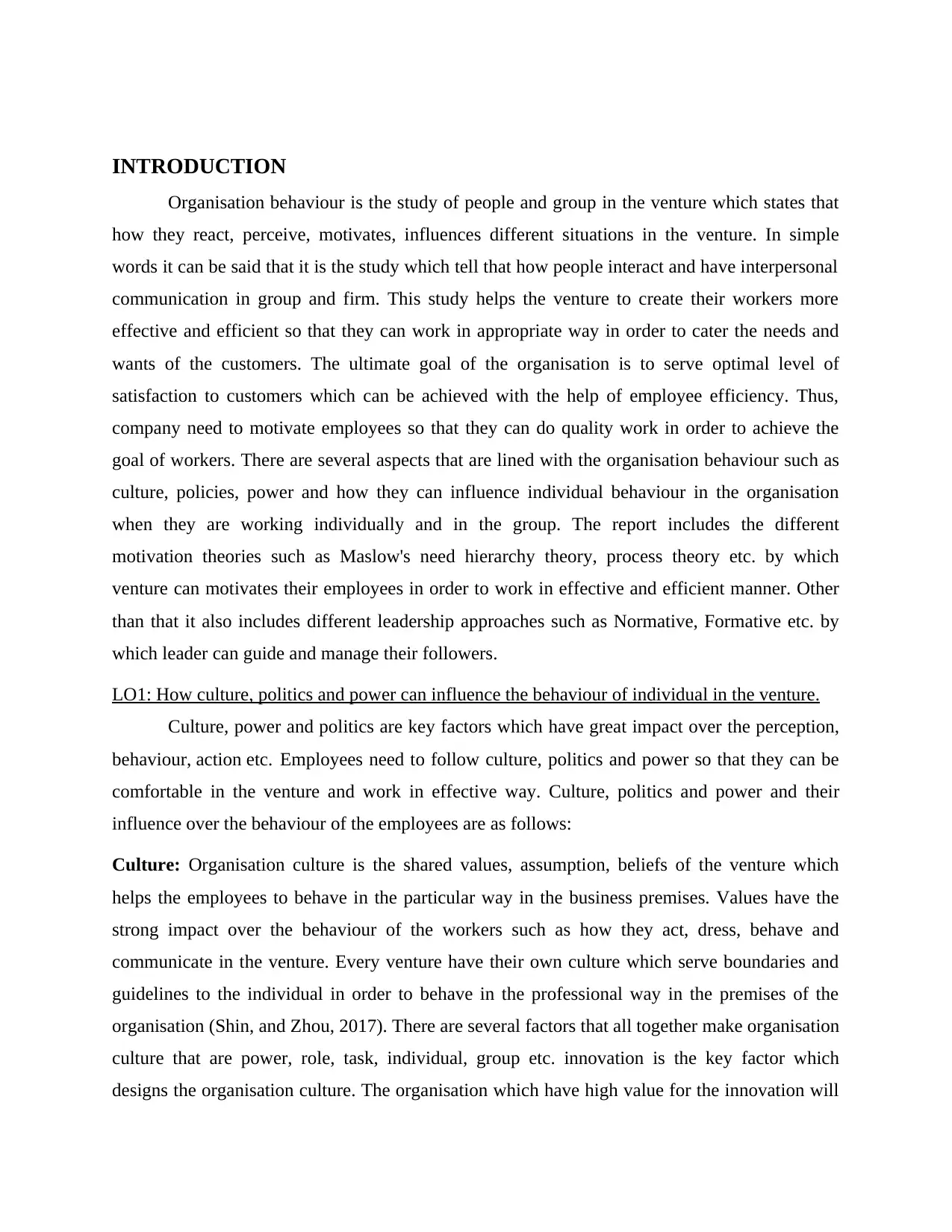
INTRODUCTION
Organisation behaviour is the study of people and group in the venture which states that
how they react, perceive, motivates, influences different situations in the venture. In simple
words it can be said that it is the study which tell that how people interact and have interpersonal
communication in group and firm. This study helps the venture to create their workers more
effective and efficient so that they can work in appropriate way in order to cater the needs and
wants of the customers. The ultimate goal of the organisation is to serve optimal level of
satisfaction to customers which can be achieved with the help of employee efficiency. Thus,
company need to motivate employees so that they can do quality work in order to achieve the
goal of workers. There are several aspects that are lined with the organisation behaviour such as
culture, policies, power and how they can influence individual behaviour in the organisation
when they are working individually and in the group. The report includes the different
motivation theories such as Maslow's need hierarchy theory, process theory etc. by which
venture can motivates their employees in order to work in effective and efficient manner. Other
than that it also includes different leadership approaches such as Normative, Formative etc. by
which leader can guide and manage their followers.
LO1: How culture, politics and power can influence the behaviour of individual in the venture.
Culture, power and politics are key factors which have great impact over the perception,
behaviour, action etc. Employees need to follow culture, politics and power so that they can be
comfortable in the venture and work in effective way. Culture, politics and power and their
influence over the behaviour of the employees are as follows:
Culture: Organisation culture is the shared values, assumption, beliefs of the venture which
helps the employees to behave in the particular way in the business premises. Values have the
strong impact over the behaviour of the workers such as how they act, dress, behave and
communicate in the venture. Every venture have their own culture which serve boundaries and
guidelines to the individual in order to behave in the professional way in the premises of the
organisation (Shin, and Zhou, 2017). There are several factors that all together make organisation
culture that are power, role, task, individual, group etc. innovation is the key factor which
designs the organisation culture. The organisation which have high value for the innovation will
Organisation behaviour is the study of people and group in the venture which states that
how they react, perceive, motivates, influences different situations in the venture. In simple
words it can be said that it is the study which tell that how people interact and have interpersonal
communication in group and firm. This study helps the venture to create their workers more
effective and efficient so that they can work in appropriate way in order to cater the needs and
wants of the customers. The ultimate goal of the organisation is to serve optimal level of
satisfaction to customers which can be achieved with the help of employee efficiency. Thus,
company need to motivate employees so that they can do quality work in order to achieve the
goal of workers. There are several aspects that are lined with the organisation behaviour such as
culture, policies, power and how they can influence individual behaviour in the organisation
when they are working individually and in the group. The report includes the different
motivation theories such as Maslow's need hierarchy theory, process theory etc. by which
venture can motivates their employees in order to work in effective and efficient manner. Other
than that it also includes different leadership approaches such as Normative, Formative etc. by
which leader can guide and manage their followers.
LO1: How culture, politics and power can influence the behaviour of individual in the venture.
Culture, power and politics are key factors which have great impact over the perception,
behaviour, action etc. Employees need to follow culture, politics and power so that they can be
comfortable in the venture and work in effective way. Culture, politics and power and their
influence over the behaviour of the employees are as follows:
Culture: Organisation culture is the shared values, assumption, beliefs of the venture which
helps the employees to behave in the particular way in the business premises. Values have the
strong impact over the behaviour of the workers such as how they act, dress, behave and
communicate in the venture. Every venture have their own culture which serve boundaries and
guidelines to the individual in order to behave in the professional way in the premises of the
organisation (Shin, and Zhou, 2017). There are several factors that all together make organisation
culture that are power, role, task, individual, group etc. innovation is the key factor which
designs the organisation culture. The organisation which have high value for the innovation will
⊘ This is a preview!⊘
Do you want full access?
Subscribe today to unlock all pages.

Trusted by 1+ million students worldwide
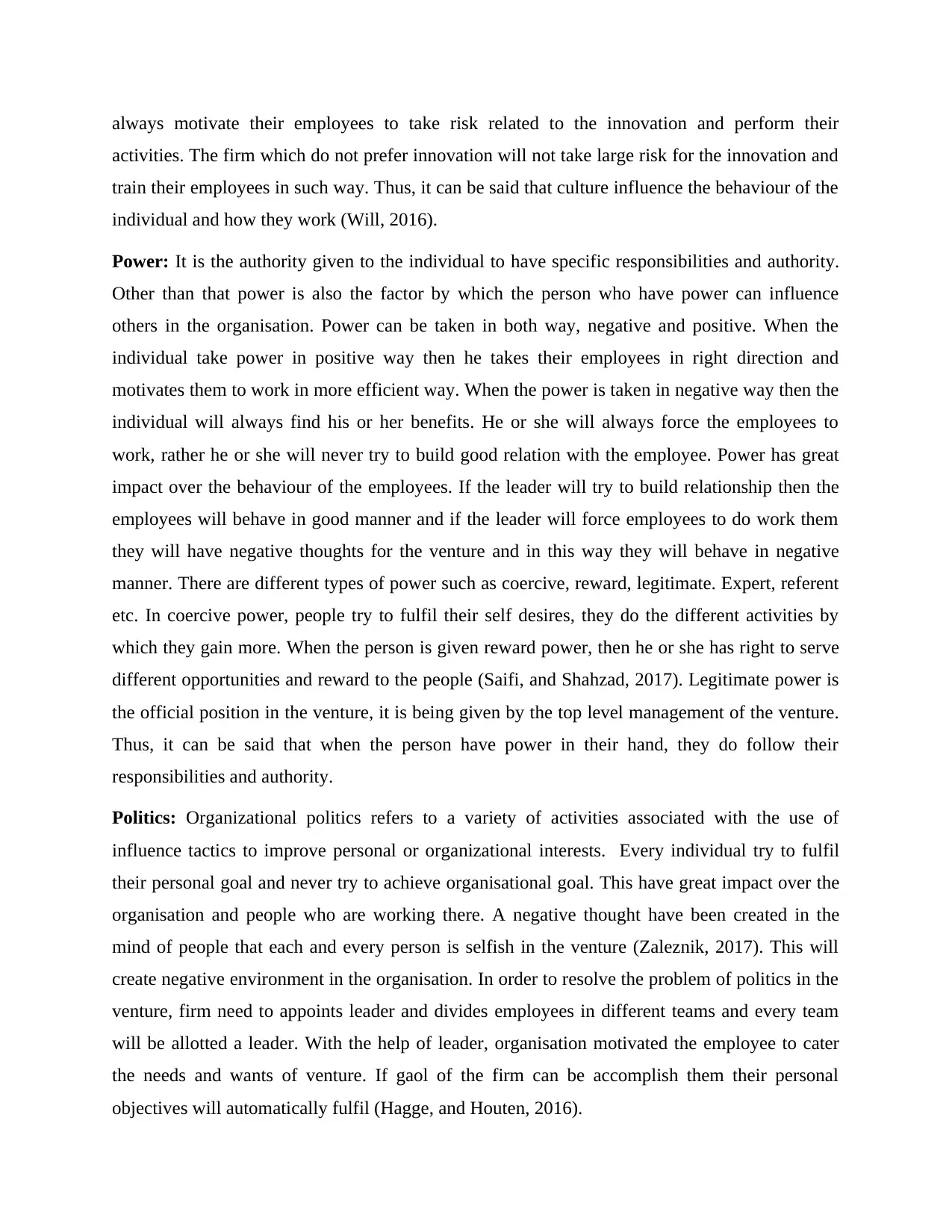
always motivate their employees to take risk related to the innovation and perform their
activities. The firm which do not prefer innovation will not take large risk for the innovation and
train their employees in such way. Thus, it can be said that culture influence the behaviour of the
individual and how they work (Will, 2016).
Power: It is the authority given to the individual to have specific responsibilities and authority.
Other than that power is also the factor by which the person who have power can influence
others in the organisation. Power can be taken in both way, negative and positive. When the
individual take power in positive way then he takes their employees in right direction and
motivates them to work in more efficient way. When the power is taken in negative way then the
individual will always find his or her benefits. He or she will always force the employees to
work, rather he or she will never try to build good relation with the employee. Power has great
impact over the behaviour of the employees. If the leader will try to build relationship then the
employees will behave in good manner and if the leader will force employees to do work them
they will have negative thoughts for the venture and in this way they will behave in negative
manner. There are different types of power such as coercive, reward, legitimate. Expert, referent
etc. In coercive power, people try to fulfil their self desires, they do the different activities by
which they gain more. When the person is given reward power, then he or she has right to serve
different opportunities and reward to the people (Saifi, and Shahzad, 2017). Legitimate power is
the official position in the venture, it is being given by the top level management of the venture.
Thus, it can be said that when the person have power in their hand, they do follow their
responsibilities and authority.
Politics: Organizational politics refers to a variety of activities associated with the use of
influence tactics to improve personal or organizational interests. Every individual try to fulfil
their personal goal and never try to achieve organisational goal. This have great impact over the
organisation and people who are working there. A negative thought have been created in the
mind of people that each and every person is selfish in the venture (Zaleznik, 2017). This will
create negative environment in the organisation. In order to resolve the problem of politics in the
venture, firm need to appoints leader and divides employees in different teams and every team
will be allotted a leader. With the help of leader, organisation motivated the employee to cater
the needs and wants of venture. If gaol of the firm can be accomplish them their personal
objectives will automatically fulfil (Hagge, and Houten, 2016).
activities. The firm which do not prefer innovation will not take large risk for the innovation and
train their employees in such way. Thus, it can be said that culture influence the behaviour of the
individual and how they work (Will, 2016).
Power: It is the authority given to the individual to have specific responsibilities and authority.
Other than that power is also the factor by which the person who have power can influence
others in the organisation. Power can be taken in both way, negative and positive. When the
individual take power in positive way then he takes their employees in right direction and
motivates them to work in more efficient way. When the power is taken in negative way then the
individual will always find his or her benefits. He or she will always force the employees to
work, rather he or she will never try to build good relation with the employee. Power has great
impact over the behaviour of the employees. If the leader will try to build relationship then the
employees will behave in good manner and if the leader will force employees to do work them
they will have negative thoughts for the venture and in this way they will behave in negative
manner. There are different types of power such as coercive, reward, legitimate. Expert, referent
etc. In coercive power, people try to fulfil their self desires, they do the different activities by
which they gain more. When the person is given reward power, then he or she has right to serve
different opportunities and reward to the people (Saifi, and Shahzad, 2017). Legitimate power is
the official position in the venture, it is being given by the top level management of the venture.
Thus, it can be said that when the person have power in their hand, they do follow their
responsibilities and authority.
Politics: Organizational politics refers to a variety of activities associated with the use of
influence tactics to improve personal or organizational interests. Every individual try to fulfil
their personal goal and never try to achieve organisational goal. This have great impact over the
organisation and people who are working there. A negative thought have been created in the
mind of people that each and every person is selfish in the venture (Zaleznik, 2017). This will
create negative environment in the organisation. In order to resolve the problem of politics in the
venture, firm need to appoints leader and divides employees in different teams and every team
will be allotted a leader. With the help of leader, organisation motivated the employee to cater
the needs and wants of venture. If gaol of the firm can be accomplish them their personal
objectives will automatically fulfil (Hagge, and Houten, 2016).
Paraphrase This Document
Need a fresh take? Get an instant paraphrase of this document with our AI Paraphraser
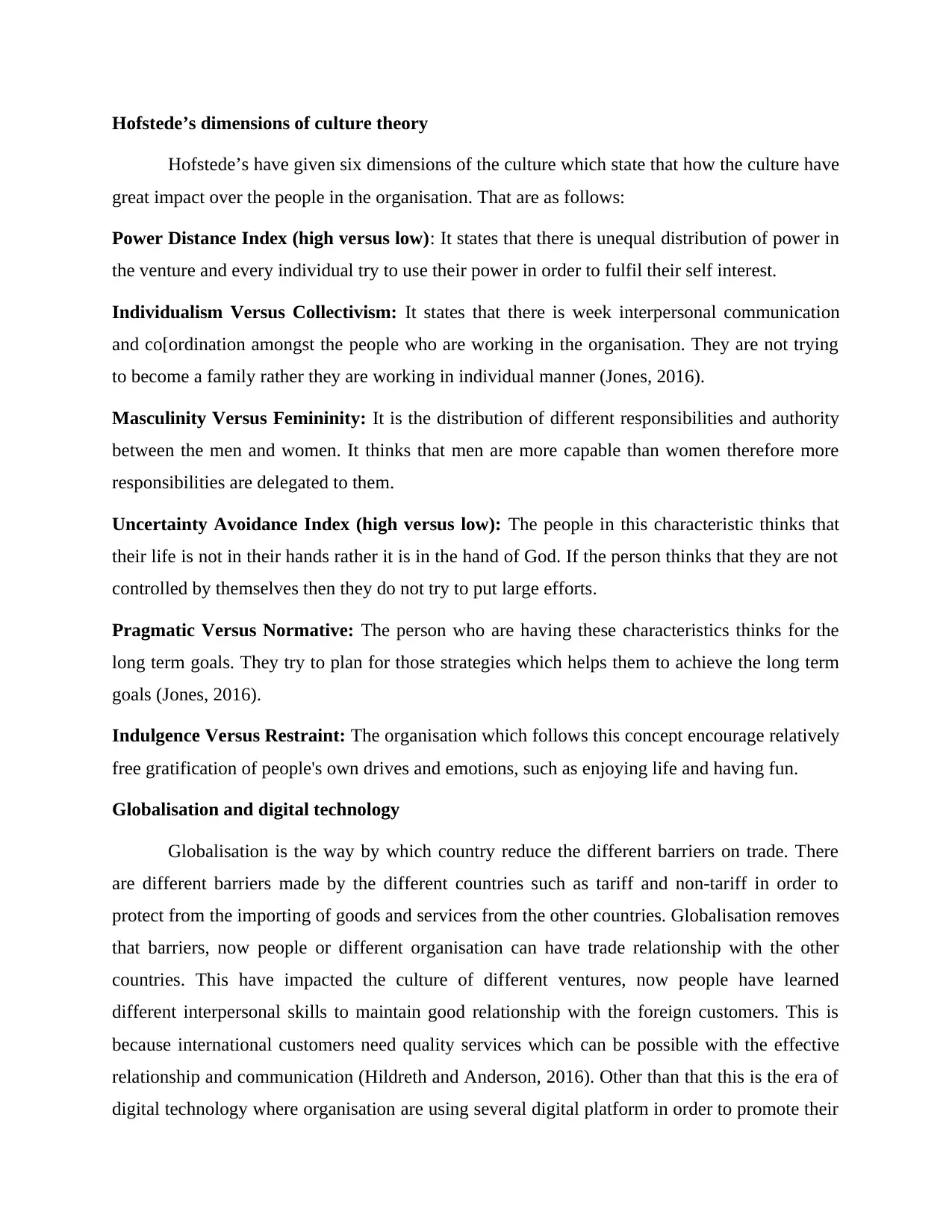
Hofstede’s dimensions of culture theory
Hofstede’s have given six dimensions of the culture which state that how the culture have
great impact over the people in the organisation. That are as follows:
Power Distance Index (high versus low): It states that there is unequal distribution of power in
the venture and every individual try to use their power in order to fulfil their self interest.
Individualism Versus Collectivism: It states that there is week interpersonal communication
and co[ordination amongst the people who are working in the organisation. They are not trying
to become a family rather they are working in individual manner (Jones, 2016).
Masculinity Versus Femininity: It is the distribution of different responsibilities and authority
between the men and women. It thinks that men are more capable than women therefore more
responsibilities are delegated to them.
Uncertainty Avoidance Index (high versus low): The people in this characteristic thinks that
their life is not in their hands rather it is in the hand of God. If the person thinks that they are not
controlled by themselves then they do not try to put large efforts.
Pragmatic Versus Normative: The person who are having these characteristics thinks for the
long term goals. They try to plan for those strategies which helps them to achieve the long term
goals (Jones, 2016).
Indulgence Versus Restraint: The organisation which follows this concept encourage relatively
free gratification of people's own drives and emotions, such as enjoying life and having fun.
Globalisation and digital technology
Globalisation is the way by which country reduce the different barriers on trade. There
are different barriers made by the different countries such as tariff and non-tariff in order to
protect from the importing of goods and services from the other countries. Globalisation removes
that barriers, now people or different organisation can have trade relationship with the other
countries. This have impacted the culture of different ventures, now people have learned
different interpersonal skills to maintain good relationship with the foreign customers. This is
because international customers need quality services which can be possible with the effective
relationship and communication (Hildreth and Anderson, 2016). Other than that this is the era of
digital technology where organisation are using several digital platform in order to promote their
Hofstede’s have given six dimensions of the culture which state that how the culture have
great impact over the people in the organisation. That are as follows:
Power Distance Index (high versus low): It states that there is unequal distribution of power in
the venture and every individual try to use their power in order to fulfil their self interest.
Individualism Versus Collectivism: It states that there is week interpersonal communication
and co[ordination amongst the people who are working in the organisation. They are not trying
to become a family rather they are working in individual manner (Jones, 2016).
Masculinity Versus Femininity: It is the distribution of different responsibilities and authority
between the men and women. It thinks that men are more capable than women therefore more
responsibilities are delegated to them.
Uncertainty Avoidance Index (high versus low): The people in this characteristic thinks that
their life is not in their hands rather it is in the hand of God. If the person thinks that they are not
controlled by themselves then they do not try to put large efforts.
Pragmatic Versus Normative: The person who are having these characteristics thinks for the
long term goals. They try to plan for those strategies which helps them to achieve the long term
goals (Jones, 2016).
Indulgence Versus Restraint: The organisation which follows this concept encourage relatively
free gratification of people's own drives and emotions, such as enjoying life and having fun.
Globalisation and digital technology
Globalisation is the way by which country reduce the different barriers on trade. There
are different barriers made by the different countries such as tariff and non-tariff in order to
protect from the importing of goods and services from the other countries. Globalisation removes
that barriers, now people or different organisation can have trade relationship with the other
countries. This have impacted the culture of different ventures, now people have learned
different interpersonal skills to maintain good relationship with the foreign customers. This is
because international customers need quality services which can be possible with the effective
relationship and communication (Hildreth and Anderson, 2016). Other than that this is the era of
digital technology where organisation are using several digital platform in order to promote their
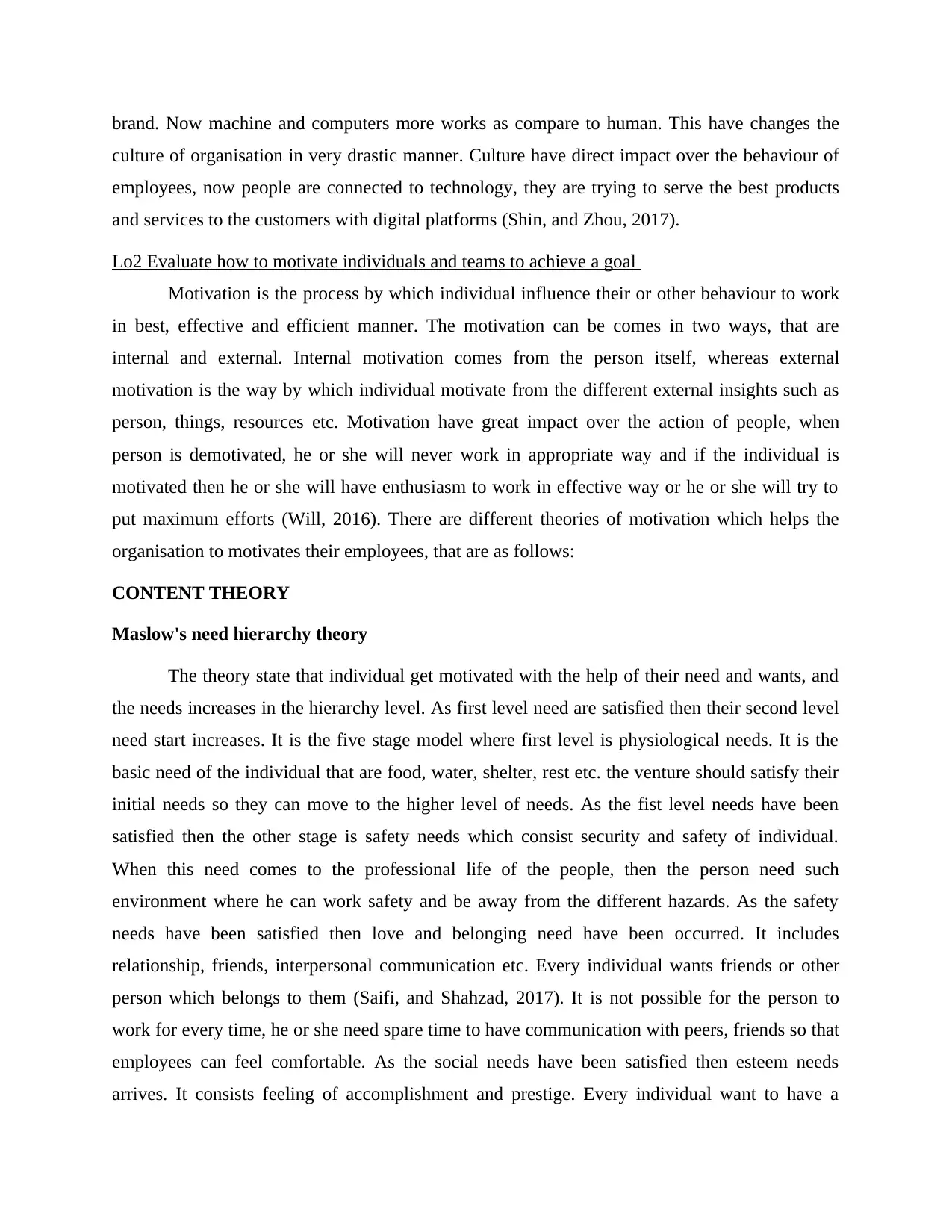
brand. Now machine and computers more works as compare to human. This have changes the
culture of organisation in very drastic manner. Culture have direct impact over the behaviour of
employees, now people are connected to technology, they are trying to serve the best products
and services to the customers with digital platforms (Shin, and Zhou, 2017).
Lo2 Evaluate how to motivate individuals and teams to achieve a goal
Motivation is the process by which individual influence their or other behaviour to work
in best, effective and efficient manner. The motivation can be comes in two ways, that are
internal and external. Internal motivation comes from the person itself, whereas external
motivation is the way by which individual motivate from the different external insights such as
person, things, resources etc. Motivation have great impact over the action of people, when
person is demotivated, he or she will never work in appropriate way and if the individual is
motivated then he or she will have enthusiasm to work in effective way or he or she will try to
put maximum efforts (Will, 2016). There are different theories of motivation which helps the
organisation to motivates their employees, that are as follows:
CONTENT THEORY
Maslow's need hierarchy theory
The theory state that individual get motivated with the help of their need and wants, and
the needs increases in the hierarchy level. As first level need are satisfied then their second level
need start increases. It is the five stage model where first level is physiological needs. It is the
basic need of the individual that are food, water, shelter, rest etc. the venture should satisfy their
initial needs so they can move to the higher level of needs. As the fist level needs have been
satisfied then the other stage is safety needs which consist security and safety of individual.
When this need comes to the professional life of the people, then the person need such
environment where he can work safety and be away from the different hazards. As the safety
needs have been satisfied then love and belonging need have been occurred. It includes
relationship, friends, interpersonal communication etc. Every individual wants friends or other
person which belongs to them (Saifi, and Shahzad, 2017). It is not possible for the person to
work for every time, he or she need spare time to have communication with peers, friends so that
employees can feel comfortable. As the social needs have been satisfied then esteem needs
arrives. It consists feeling of accomplishment and prestige. Every individual want to have a
culture of organisation in very drastic manner. Culture have direct impact over the behaviour of
employees, now people are connected to technology, they are trying to serve the best products
and services to the customers with digital platforms (Shin, and Zhou, 2017).
Lo2 Evaluate how to motivate individuals and teams to achieve a goal
Motivation is the process by which individual influence their or other behaviour to work
in best, effective and efficient manner. The motivation can be comes in two ways, that are
internal and external. Internal motivation comes from the person itself, whereas external
motivation is the way by which individual motivate from the different external insights such as
person, things, resources etc. Motivation have great impact over the action of people, when
person is demotivated, he or she will never work in appropriate way and if the individual is
motivated then he or she will have enthusiasm to work in effective way or he or she will try to
put maximum efforts (Will, 2016). There are different theories of motivation which helps the
organisation to motivates their employees, that are as follows:
CONTENT THEORY
Maslow's need hierarchy theory
The theory state that individual get motivated with the help of their need and wants, and
the needs increases in the hierarchy level. As first level need are satisfied then their second level
need start increases. It is the five stage model where first level is physiological needs. It is the
basic need of the individual that are food, water, shelter, rest etc. the venture should satisfy their
initial needs so they can move to the higher level of needs. As the fist level needs have been
satisfied then the other stage is safety needs which consist security and safety of individual.
When this need comes to the professional life of the people, then the person need such
environment where he can work safety and be away from the different hazards. As the safety
needs have been satisfied then love and belonging need have been occurred. It includes
relationship, friends, interpersonal communication etc. Every individual wants friends or other
person which belongs to them (Saifi, and Shahzad, 2017). It is not possible for the person to
work for every time, he or she need spare time to have communication with peers, friends so that
employees can feel comfortable. As the social needs have been satisfied then esteem needs
arrives. It consists feeling of accomplishment and prestige. Every individual want to have a
⊘ This is a preview!⊘
Do you want full access?
Subscribe today to unlock all pages.

Trusted by 1+ million students worldwide
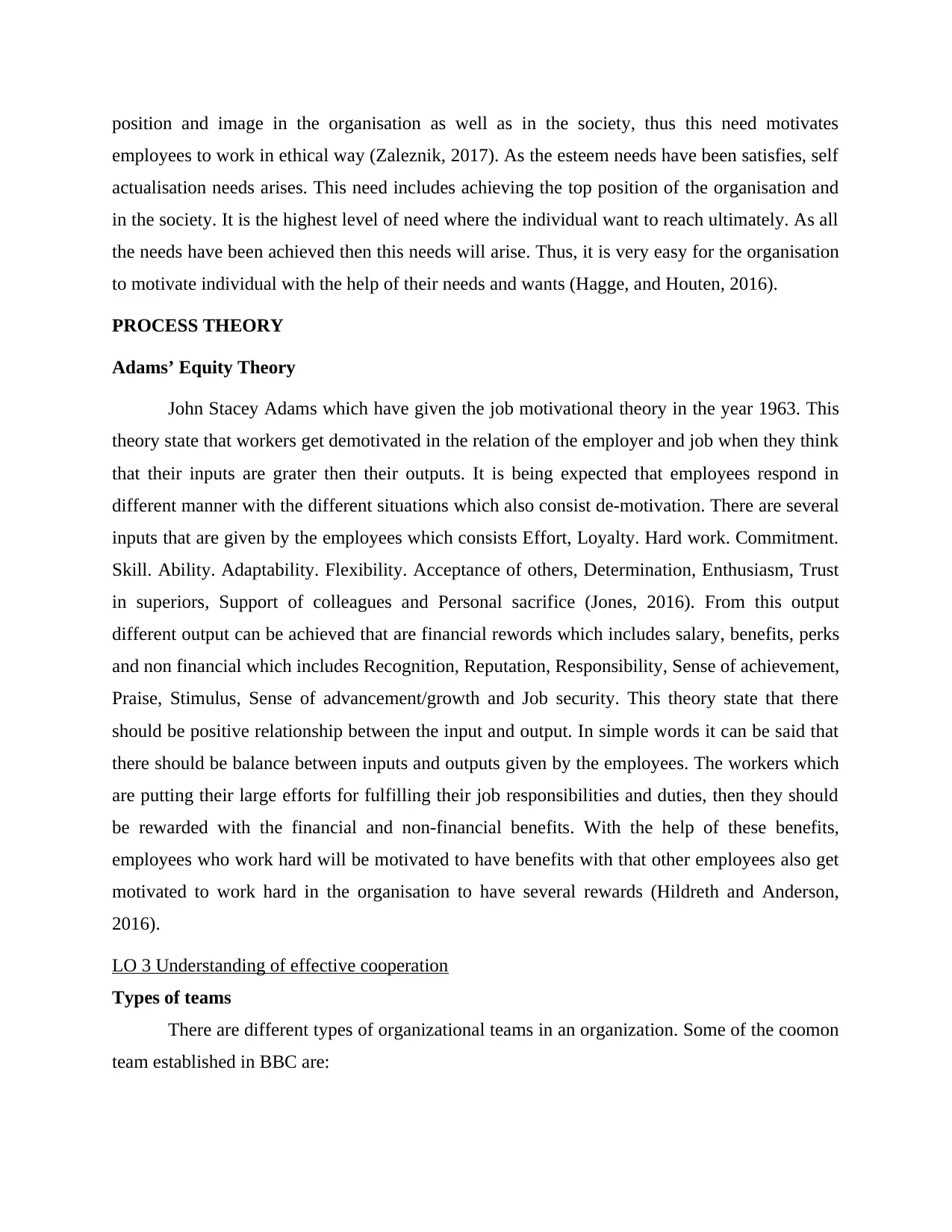
position and image in the organisation as well as in the society, thus this need motivates
employees to work in ethical way (Zaleznik, 2017). As the esteem needs have been satisfies, self
actualisation needs arises. This need includes achieving the top position of the organisation and
in the society. It is the highest level of need where the individual want to reach ultimately. As all
the needs have been achieved then this needs will arise. Thus, it is very easy for the organisation
to motivate individual with the help of their needs and wants (Hagge, and Houten, 2016).
PROCESS THEORY
Adams’ Equity Theory
John Stacey Adams which have given the job motivational theory in the year 1963. This
theory state that workers get demotivated in the relation of the employer and job when they think
that their inputs are grater then their outputs. It is being expected that employees respond in
different manner with the different situations which also consist de-motivation. There are several
inputs that are given by the employees which consists Effort, Loyalty. Hard work. Commitment.
Skill. Ability. Adaptability. Flexibility. Acceptance of others, Determination, Enthusiasm, Trust
in superiors, Support of colleagues and Personal sacrifice (Jones, 2016). From this output
different output can be achieved that are financial rewords which includes salary, benefits, perks
and non financial which includes Recognition, Reputation, Responsibility, Sense of achievement,
Praise, Stimulus, Sense of advancement/growth and Job security. This theory state that there
should be positive relationship between the input and output. In simple words it can be said that
there should be balance between inputs and outputs given by the employees. The workers which
are putting their large efforts for fulfilling their job responsibilities and duties, then they should
be rewarded with the financial and non-financial benefits. With the help of these benefits,
employees who work hard will be motivated to have benefits with that other employees also get
motivated to work hard in the organisation to have several rewards (Hildreth and Anderson,
2016).
LO 3 Understanding of effective cooperation
Types of teams
There are different types of organizational teams in an organization. Some of the coomon
team established in BBC are:
employees to work in ethical way (Zaleznik, 2017). As the esteem needs have been satisfies, self
actualisation needs arises. This need includes achieving the top position of the organisation and
in the society. It is the highest level of need where the individual want to reach ultimately. As all
the needs have been achieved then this needs will arise. Thus, it is very easy for the organisation
to motivate individual with the help of their needs and wants (Hagge, and Houten, 2016).
PROCESS THEORY
Adams’ Equity Theory
John Stacey Adams which have given the job motivational theory in the year 1963. This
theory state that workers get demotivated in the relation of the employer and job when they think
that their inputs are grater then their outputs. It is being expected that employees respond in
different manner with the different situations which also consist de-motivation. There are several
inputs that are given by the employees which consists Effort, Loyalty. Hard work. Commitment.
Skill. Ability. Adaptability. Flexibility. Acceptance of others, Determination, Enthusiasm, Trust
in superiors, Support of colleagues and Personal sacrifice (Jones, 2016). From this output
different output can be achieved that are financial rewords which includes salary, benefits, perks
and non financial which includes Recognition, Reputation, Responsibility, Sense of achievement,
Praise, Stimulus, Sense of advancement/growth and Job security. This theory state that there
should be positive relationship between the input and output. In simple words it can be said that
there should be balance between inputs and outputs given by the employees. The workers which
are putting their large efforts for fulfilling their job responsibilities and duties, then they should
be rewarded with the financial and non-financial benefits. With the help of these benefits,
employees who work hard will be motivated to have benefits with that other employees also get
motivated to work hard in the organisation to have several rewards (Hildreth and Anderson,
2016).
LO 3 Understanding of effective cooperation
Types of teams
There are different types of organizational teams in an organization. Some of the coomon
team established in BBC are:
Paraphrase This Document
Need a fresh take? Get an instant paraphrase of this document with our AI Paraphraser
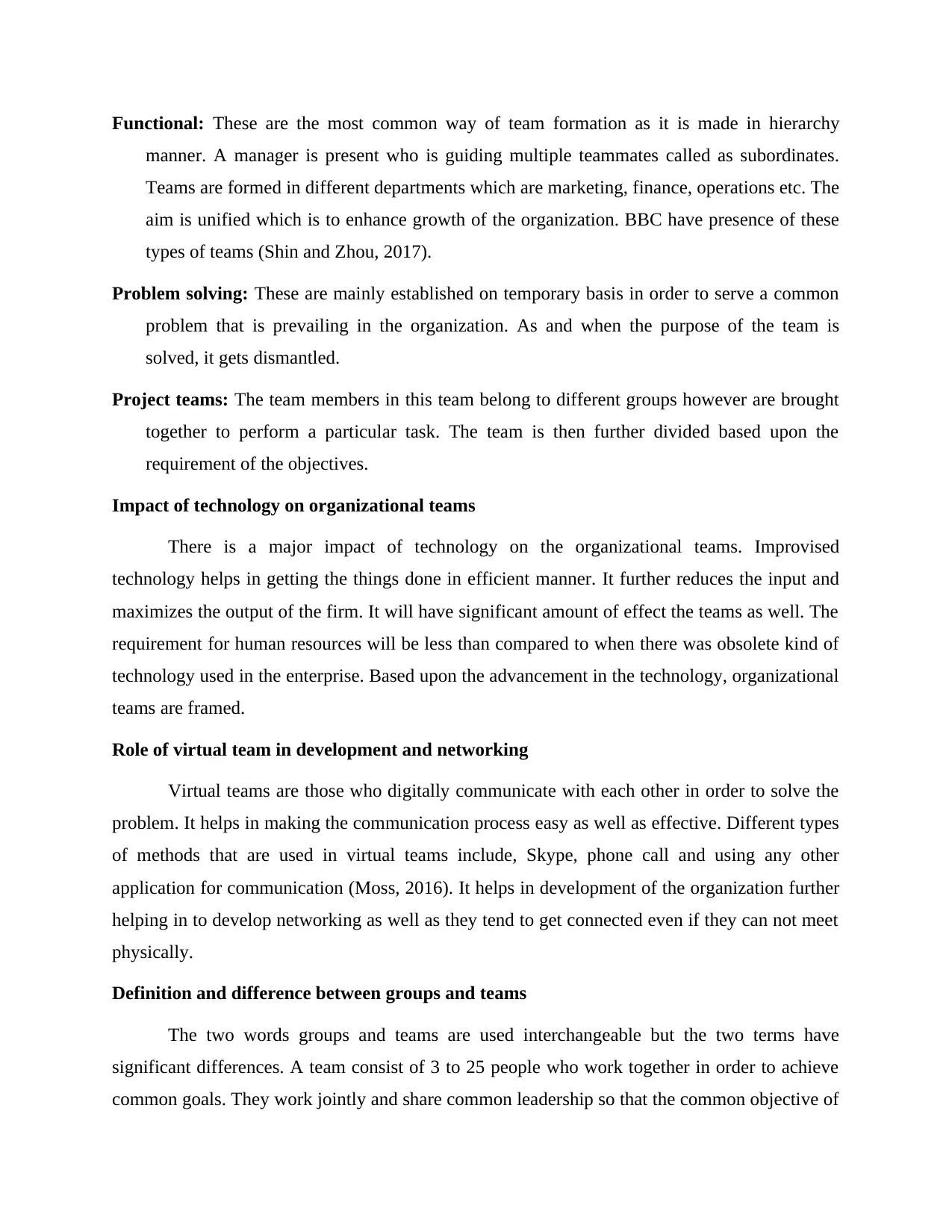
Functional: These are the most common way of team formation as it is made in hierarchy
manner. A manager is present who is guiding multiple teammates called as subordinates.
Teams are formed in different departments which are marketing, finance, operations etc. The
aim is unified which is to enhance growth of the organization. BBC have presence of these
types of teams (Shin and Zhou, 2017).
Problem solving: These are mainly established on temporary basis in order to serve a common
problem that is prevailing in the organization. As and when the purpose of the team is
solved, it gets dismantled.
Project teams: The team members in this team belong to different groups however are brought
together to perform a particular task. The team is then further divided based upon the
requirement of the objectives.
Impact of technology on organizational teams
There is a major impact of technology on the organizational teams. Improvised
technology helps in getting the things done in efficient manner. It further reduces the input and
maximizes the output of the firm. It will have significant amount of effect the teams as well. The
requirement for human resources will be less than compared to when there was obsolete kind of
technology used in the enterprise. Based upon the advancement in the technology, organizational
teams are framed.
Role of virtual team in development and networking
Virtual teams are those who digitally communicate with each other in order to solve the
problem. It helps in making the communication process easy as well as effective. Different types
of methods that are used in virtual teams include, Skype, phone call and using any other
application for communication (Moss, 2016). It helps in development of the organization further
helping in to develop networking as well as they tend to get connected even if they can not meet
physically.
Definition and difference between groups and teams
The two words groups and teams are used interchangeable but the two terms have
significant differences. A team consist of 3 to 25 people who work together in order to achieve
common goals. They work jointly and share common leadership so that the common objective of
manner. A manager is present who is guiding multiple teammates called as subordinates.
Teams are formed in different departments which are marketing, finance, operations etc. The
aim is unified which is to enhance growth of the organization. BBC have presence of these
types of teams (Shin and Zhou, 2017).
Problem solving: These are mainly established on temporary basis in order to serve a common
problem that is prevailing in the organization. As and when the purpose of the team is
solved, it gets dismantled.
Project teams: The team members in this team belong to different groups however are brought
together to perform a particular task. The team is then further divided based upon the
requirement of the objectives.
Impact of technology on organizational teams
There is a major impact of technology on the organizational teams. Improvised
technology helps in getting the things done in efficient manner. It further reduces the input and
maximizes the output of the firm. It will have significant amount of effect the teams as well. The
requirement for human resources will be less than compared to when there was obsolete kind of
technology used in the enterprise. Based upon the advancement in the technology, organizational
teams are framed.
Role of virtual team in development and networking
Virtual teams are those who digitally communicate with each other in order to solve the
problem. It helps in making the communication process easy as well as effective. Different types
of methods that are used in virtual teams include, Skype, phone call and using any other
application for communication (Moss, 2016). It helps in development of the organization further
helping in to develop networking as well as they tend to get connected even if they can not meet
physically.
Definition and difference between groups and teams
The two words groups and teams are used interchangeable but the two terms have
significant differences. A team consist of 3 to 25 people who work together in order to achieve
common goals. They work jointly and share common leadership so that the common objective of
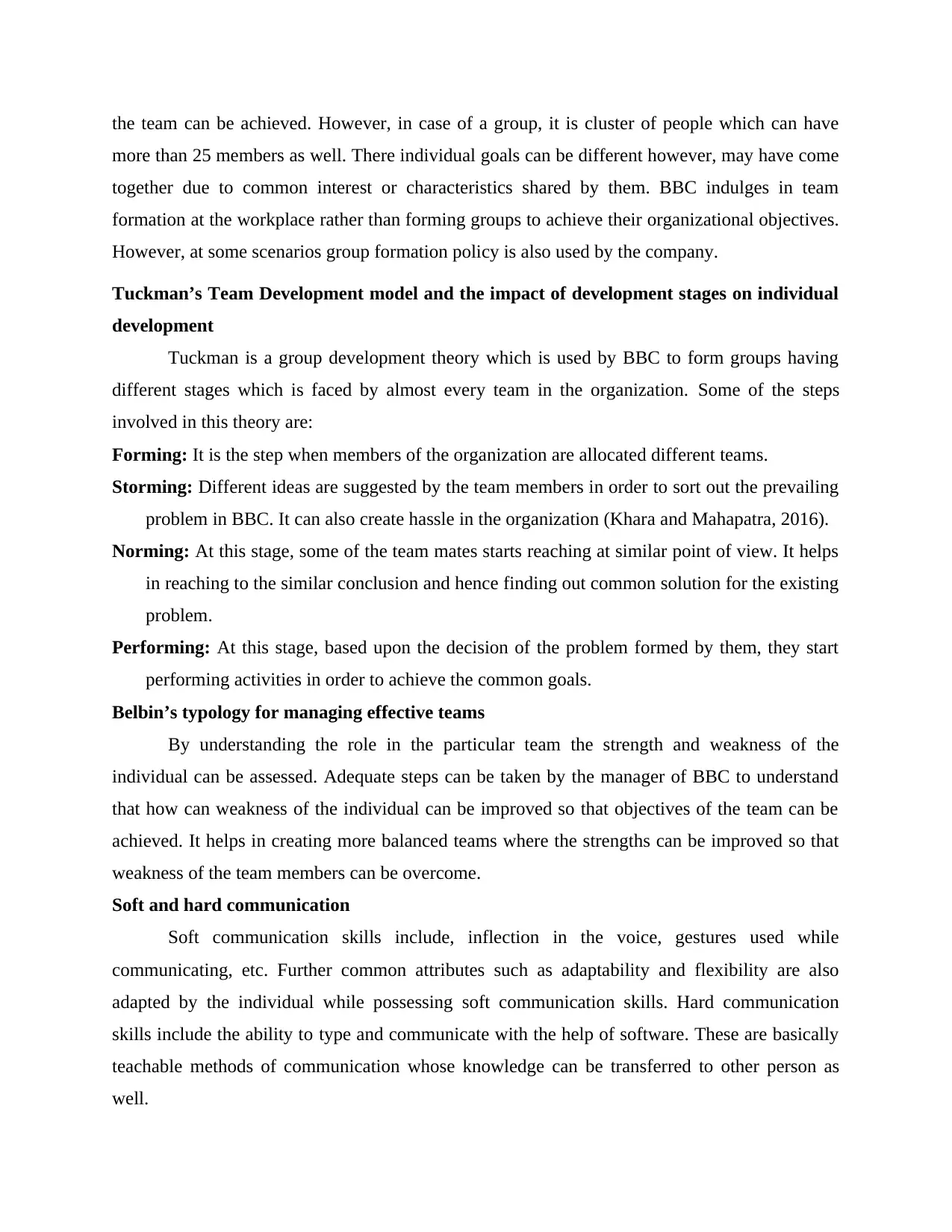
the team can be achieved. However, in case of a group, it is cluster of people which can have
more than 25 members as well. There individual goals can be different however, may have come
together due to common interest or characteristics shared by them. BBC indulges in team
formation at the workplace rather than forming groups to achieve their organizational objectives.
However, at some scenarios group formation policy is also used by the company.
Tuckman’s Team Development model and the impact of development stages on individual
development
Tuckman is a group development theory which is used by BBC to form groups having
different stages which is faced by almost every team in the organization. Some of the steps
involved in this theory are:
Forming: It is the step when members of the organization are allocated different teams.
Storming: Different ideas are suggested by the team members in order to sort out the prevailing
problem in BBC. It can also create hassle in the organization (Khara and Mahapatra, 2016).
Norming: At this stage, some of the team mates starts reaching at similar point of view. It helps
in reaching to the similar conclusion and hence finding out common solution for the existing
problem.
Performing: At this stage, based upon the decision of the problem formed by them, they start
performing activities in order to achieve the common goals.
Belbin’s typology for managing effective teams
By understanding the role in the particular team the strength and weakness of the
individual can be assessed. Adequate steps can be taken by the manager of BBC to understand
that how can weakness of the individual can be improved so that objectives of the team can be
achieved. It helps in creating more balanced teams where the strengths can be improved so that
weakness of the team members can be overcome.
Soft and hard communication
Soft communication skills include, inflection in the voice, gestures used while
communicating, etc. Further common attributes such as adaptability and flexibility are also
adapted by the individual while possessing soft communication skills. Hard communication
skills include the ability to type and communicate with the help of software. These are basically
teachable methods of communication whose knowledge can be transferred to other person as
well.
more than 25 members as well. There individual goals can be different however, may have come
together due to common interest or characteristics shared by them. BBC indulges in team
formation at the workplace rather than forming groups to achieve their organizational objectives.
However, at some scenarios group formation policy is also used by the company.
Tuckman’s Team Development model and the impact of development stages on individual
development
Tuckman is a group development theory which is used by BBC to form groups having
different stages which is faced by almost every team in the organization. Some of the steps
involved in this theory are:
Forming: It is the step when members of the organization are allocated different teams.
Storming: Different ideas are suggested by the team members in order to sort out the prevailing
problem in BBC. It can also create hassle in the organization (Khara and Mahapatra, 2016).
Norming: At this stage, some of the team mates starts reaching at similar point of view. It helps
in reaching to the similar conclusion and hence finding out common solution for the existing
problem.
Performing: At this stage, based upon the decision of the problem formed by them, they start
performing activities in order to achieve the common goals.
Belbin’s typology for managing effective teams
By understanding the role in the particular team the strength and weakness of the
individual can be assessed. Adequate steps can be taken by the manager of BBC to understand
that how can weakness of the individual can be improved so that objectives of the team can be
achieved. It helps in creating more balanced teams where the strengths can be improved so that
weakness of the team members can be overcome.
Soft and hard communication
Soft communication skills include, inflection in the voice, gestures used while
communicating, etc. Further common attributes such as adaptability and flexibility are also
adapted by the individual while possessing soft communication skills. Hard communication
skills include the ability to type and communicate with the help of software. These are basically
teachable methods of communication whose knowledge can be transferred to other person as
well.
⊘ This is a preview!⊘
Do you want full access?
Subscribe today to unlock all pages.

Trusted by 1+ million students worldwide
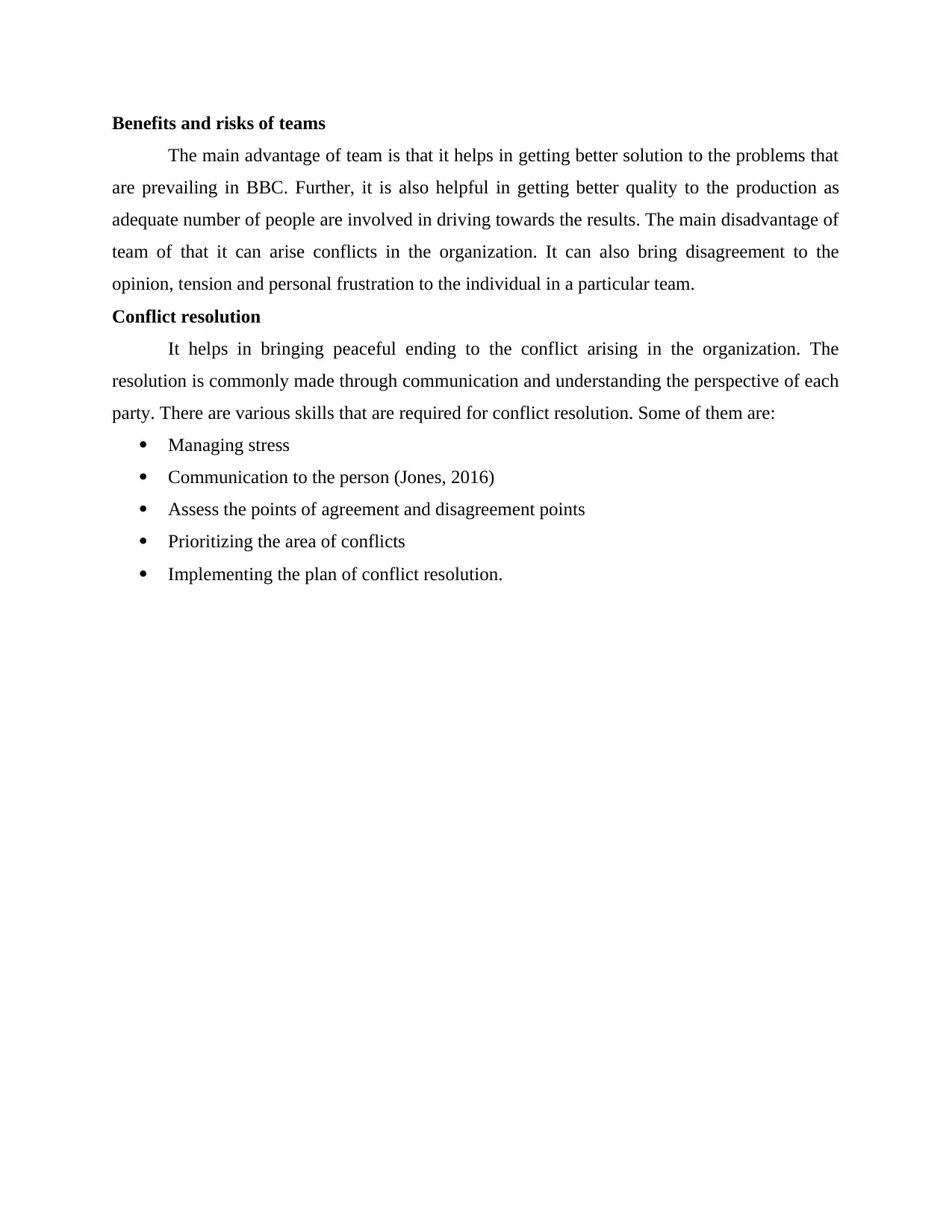
Benefits and risks of teams
The main advantage of team is that it helps in getting better solution to the problems that
are prevailing in BBC. Further, it is also helpful in getting better quality to the production as
adequate number of people are involved in driving towards the results. The main disadvantage of
team of that it can arise conflicts in the organization. It can also bring disagreement to the
opinion, tension and personal frustration to the individual in a particular team.
Conflict resolution
It helps in bringing peaceful ending to the conflict arising in the organization. The
resolution is commonly made through communication and understanding the perspective of each
party. There are various skills that are required for conflict resolution. Some of them are:
Managing stress
Communication to the person (Jones, 2016)
Assess the points of agreement and disagreement points
Prioritizing the area of conflicts
Implementing the plan of conflict resolution.
The main advantage of team is that it helps in getting better solution to the problems that
are prevailing in BBC. Further, it is also helpful in getting better quality to the production as
adequate number of people are involved in driving towards the results. The main disadvantage of
team of that it can arise conflicts in the organization. It can also bring disagreement to the
opinion, tension and personal frustration to the individual in a particular team.
Conflict resolution
It helps in bringing peaceful ending to the conflict arising in the organization. The
resolution is commonly made through communication and understanding the perspective of each
party. There are various skills that are required for conflict resolution. Some of them are:
Managing stress
Communication to the person (Jones, 2016)
Assess the points of agreement and disagreement points
Prioritizing the area of conflicts
Implementing the plan of conflict resolution.
Paraphrase This Document
Need a fresh take? Get an instant paraphrase of this document with our AI Paraphraser
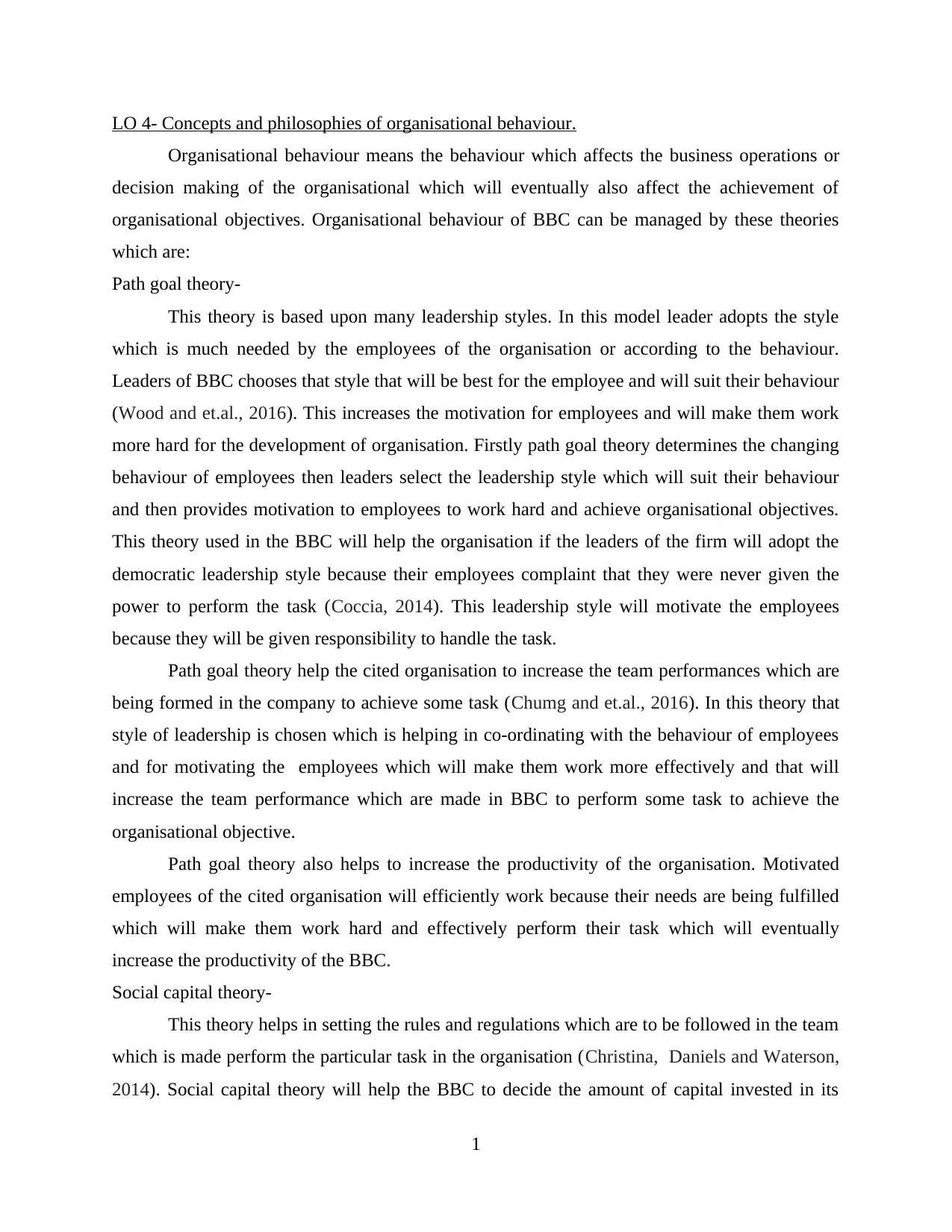
LO 4- Concepts and philosophies of organisational behaviour.
Organisational behaviour means the behaviour which affects the business operations or
decision making of the organisational which will eventually also affect the achievement of
organisational objectives. Organisational behaviour of BBC can be managed by these theories
which are:
Path goal theory-
This theory is based upon many leadership styles. In this model leader adopts the style
which is much needed by the employees of the organisation or according to the behaviour.
Leaders of BBC chooses that style that will be best for the employee and will suit their behaviour
(Wood and et.al., 2016). This increases the motivation for employees and will make them work
more hard for the development of organisation. Firstly path goal theory determines the changing
behaviour of employees then leaders select the leadership style which will suit their behaviour
and then provides motivation to employees to work hard and achieve organisational objectives.
This theory used in the BBC will help the organisation if the leaders of the firm will adopt the
democratic leadership style because their employees complaint that they were never given the
power to perform the task (Coccia, 2014). This leadership style will motivate the employees
because they will be given responsibility to handle the task.
Path goal theory help the cited organisation to increase the team performances which are
being formed in the company to achieve some task (Chumg and et.al., 2016). In this theory that
style of leadership is chosen which is helping in co-ordinating with the behaviour of employees
and for motivating the employees which will make them work more effectively and that will
increase the team performance which are made in BBC to perform some task to achieve the
organisational objective.
Path goal theory also helps to increase the productivity of the organisation. Motivated
employees of the cited organisation will efficiently work because their needs are being fulfilled
which will make them work hard and effectively perform their task which will eventually
increase the productivity of the BBC.
Social capital theory-
This theory helps in setting the rules and regulations which are to be followed in the team
which is made perform the particular task in the organisation (Christina, Daniels and Waterson,
2014). Social capital theory will help the BBC to decide the amount of capital invested in its
1
Organisational behaviour means the behaviour which affects the business operations or
decision making of the organisational which will eventually also affect the achievement of
organisational objectives. Organisational behaviour of BBC can be managed by these theories
which are:
Path goal theory-
This theory is based upon many leadership styles. In this model leader adopts the style
which is much needed by the employees of the organisation or according to the behaviour.
Leaders of BBC chooses that style that will be best for the employee and will suit their behaviour
(Wood and et.al., 2016). This increases the motivation for employees and will make them work
more hard for the development of organisation. Firstly path goal theory determines the changing
behaviour of employees then leaders select the leadership style which will suit their behaviour
and then provides motivation to employees to work hard and achieve organisational objectives.
This theory used in the BBC will help the organisation if the leaders of the firm will adopt the
democratic leadership style because their employees complaint that they were never given the
power to perform the task (Coccia, 2014). This leadership style will motivate the employees
because they will be given responsibility to handle the task.
Path goal theory help the cited organisation to increase the team performances which are
being formed in the company to achieve some task (Chumg and et.al., 2016). In this theory that
style of leadership is chosen which is helping in co-ordinating with the behaviour of employees
and for motivating the employees which will make them work more effectively and that will
increase the team performance which are made in BBC to perform some task to achieve the
organisational objective.
Path goal theory also helps to increase the productivity of the organisation. Motivated
employees of the cited organisation will efficiently work because their needs are being fulfilled
which will make them work hard and effectively perform their task which will eventually
increase the productivity of the BBC.
Social capital theory-
This theory helps in setting the rules and regulations which are to be followed in the team
which is made perform the particular task in the organisation (Christina, Daniels and Waterson,
2014). Social capital theory will help the BBC to decide the amount of capital invested in its
1
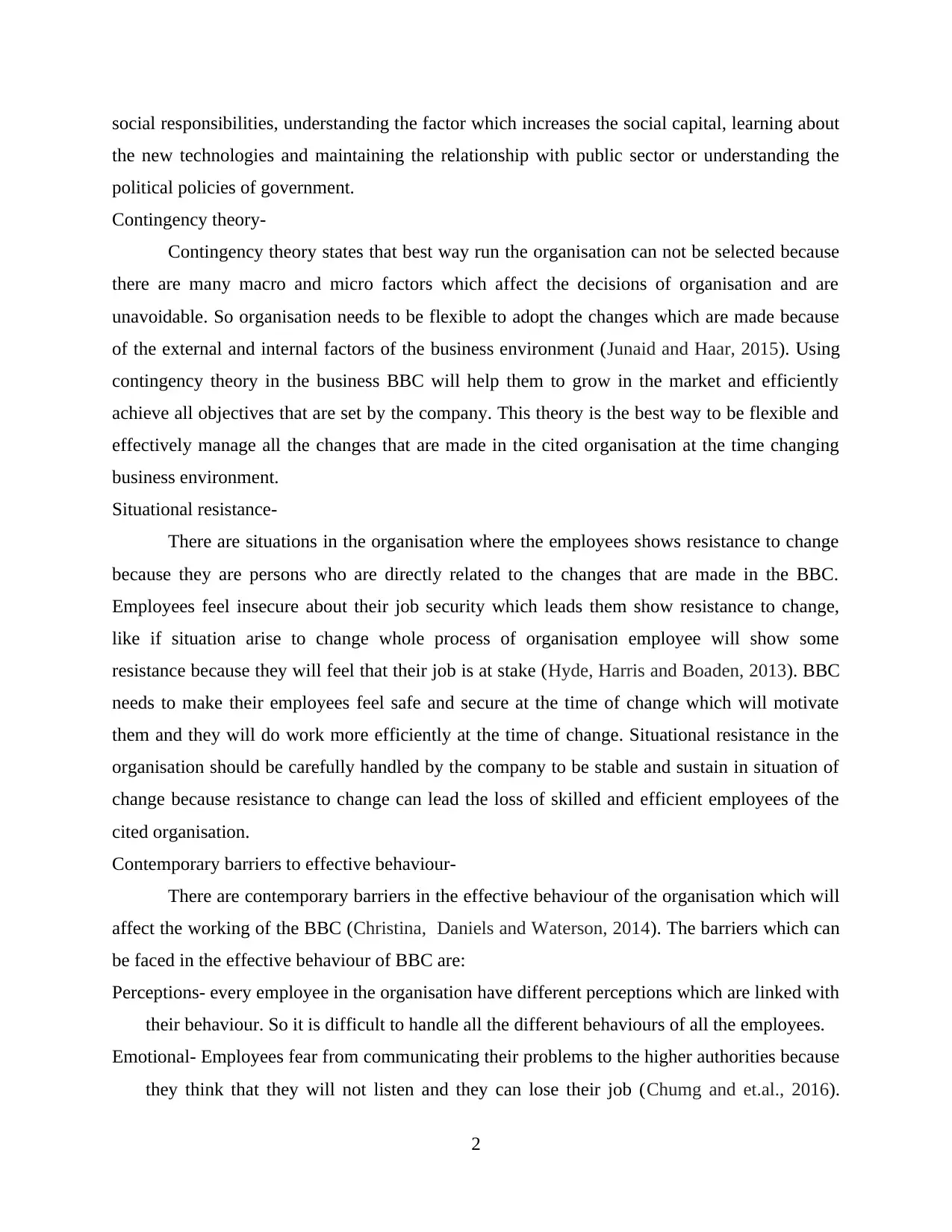
social responsibilities, understanding the factor which increases the social capital, learning about
the new technologies and maintaining the relationship with public sector or understanding the
political policies of government.
Contingency theory-
Contingency theory states that best way run the organisation can not be selected because
there are many macro and micro factors which affect the decisions of organisation and are
unavoidable. So organisation needs to be flexible to adopt the changes which are made because
of the external and internal factors of the business environment (Junaid and Haar, 2015). Using
contingency theory in the business BBC will help them to grow in the market and efficiently
achieve all objectives that are set by the company. This theory is the best way to be flexible and
effectively manage all the changes that are made in the cited organisation at the time changing
business environment.
Situational resistance-
There are situations in the organisation where the employees shows resistance to change
because they are persons who are directly related to the changes that are made in the BBC.
Employees feel insecure about their job security which leads them show resistance to change,
like if situation arise to change whole process of organisation employee will show some
resistance because they will feel that their job is at stake (Hyde, Harris and Boaden, 2013). BBC
needs to make their employees feel safe and secure at the time of change which will motivate
them and they will do work more efficiently at the time of change. Situational resistance in the
organisation should be carefully handled by the company to be stable and sustain in situation of
change because resistance to change can lead the loss of skilled and efficient employees of the
cited organisation.
Contemporary barriers to effective behaviour-
There are contemporary barriers in the effective behaviour of the organisation which will
affect the working of the BBC (Christina, Daniels and Waterson, 2014). The barriers which can
be faced in the effective behaviour of BBC are:
Perceptions- every employee in the organisation have different perceptions which are linked with
their behaviour. So it is difficult to handle all the different behaviours of all the employees.
Emotional- Employees fear from communicating their problems to the higher authorities because
they think that they will not listen and they can lose their job (Chumg and et.al., 2016).
2
the new technologies and maintaining the relationship with public sector or understanding the
political policies of government.
Contingency theory-
Contingency theory states that best way run the organisation can not be selected because
there are many macro and micro factors which affect the decisions of organisation and are
unavoidable. So organisation needs to be flexible to adopt the changes which are made because
of the external and internal factors of the business environment (Junaid and Haar, 2015). Using
contingency theory in the business BBC will help them to grow in the market and efficiently
achieve all objectives that are set by the company. This theory is the best way to be flexible and
effectively manage all the changes that are made in the cited organisation at the time changing
business environment.
Situational resistance-
There are situations in the organisation where the employees shows resistance to change
because they are persons who are directly related to the changes that are made in the BBC.
Employees feel insecure about their job security which leads them show resistance to change,
like if situation arise to change whole process of organisation employee will show some
resistance because they will feel that their job is at stake (Hyde, Harris and Boaden, 2013). BBC
needs to make their employees feel safe and secure at the time of change which will motivate
them and they will do work more efficiently at the time of change. Situational resistance in the
organisation should be carefully handled by the company to be stable and sustain in situation of
change because resistance to change can lead the loss of skilled and efficient employees of the
cited organisation.
Contemporary barriers to effective behaviour-
There are contemporary barriers in the effective behaviour of the organisation which will
affect the working of the BBC (Christina, Daniels and Waterson, 2014). The barriers which can
be faced in the effective behaviour of BBC are:
Perceptions- every employee in the organisation have different perceptions which are linked with
their behaviour. So it is difficult to handle all the different behaviours of all the employees.
Emotional- Employees fear from communicating their problems to the higher authorities because
they think that they will not listen and they can lose their job (Chumg and et.al., 2016).
2
⊘ This is a preview!⊘
Do you want full access?
Subscribe today to unlock all pages.

Trusted by 1+ million students worldwide
1 out of 16
Related Documents
Your All-in-One AI-Powered Toolkit for Academic Success.
+13062052269
info@desklib.com
Available 24*7 on WhatsApp / Email
![[object Object]](/_next/static/media/star-bottom.7253800d.svg)
Unlock your academic potential
Copyright © 2020–2025 A2Z Services. All Rights Reserved. Developed and managed by ZUCOL.





